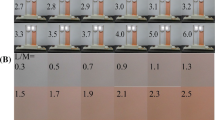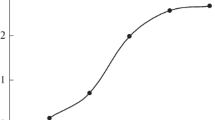Summary
Metals and indicators usually form more than one complex in solution. Besides the complexes MI and MI2, M2 and M2I2 are also known. When one of the latter two predominates in solution, systematic deviations can theoretically be expected in chelatometric titrations of micromole amounts. This has been confirmed experimentally in titrations of Fe, Bi and Th with EDTA by using triphenylmethane dyes such as Xylenol Orange and Chromazurol S (CAS) as indicator. When titrations are performed with indicators which predominantly form MI n , as indicators of the azo type do, accurate results have experimentally been found in agreement with the theory. When such an indicator is not available, a proper wavelength selection will sometimes improve the accuracy, but in most cases back-titrations are preferable.
Zusammenfassung
Metalle (M) bilden mit Indikatoren (I) gewöhnlich mehr als eine Komplex-Verbindung. Neben MI und MI sind auch M2I und M2I2 bekannt. Überwiegt eine der beiden letztgenannten Verbindungen in einer Lösung, so sind theoretisch bei der Titration von Mikrogrammengen systematische Fehler zu erwarten. Dies wurde experimentell bestätigt bei Titrationen von Fe, Bi und Th mit ÄDTA gegen Triphenylmethanfarbstoffe wie Xylenolorange und Chromazurol S als Indikator. Bei Titrationen gegen Indikatoren, die vorwiegend MI n -Komplexe bilden, wie z. B. Azofarbstoffe, werden in Übereinstimmung mit dieser Theorie genaue Ergebnisse erhalten. Ist ein solcher Indikator nicht greifbar, so verbessert manchmal die genaue Auswahl der Wellenlänge die Genauigkeit, aber meist sind Rücktitrationen vorzuziehen.
Similar content being viewed by others
References
J. Kragten, Talanta,18, 311 (1971).
F.Freese, Thesis 1971, University of Amsterdam.
J. Kragten, Analyst,96, 106 (1971).
J. Kragten, VI International Symposium on Microtechniques, Graz (Austria), Verlag der Wiener Medizinischen Akademie1970, B 27, 149.
S. Kotrlý, Analyt. Chim. Acta29, 552 (1963).
A. Ringbom, Complexation in Analytical Chemistry. New York-London: Interscience. 1963. p. 38.
K. S. Klausen andF. J. Langmyhr, Analyt. Chim. Acta29, 149 (1963).
K. S. Klausen andF. J. Langmyhr, Analyt. Chim. Acta44, 377 (1969).
B. Buděšínský, Z. analyt. Chem.207, 247 (1965).
B. Buděšínský, Z. analyt. Chem.209, 279 (1965).
B. Buděšínský, Coll. Czechoslov. Chemic. Commun.28, 1858 (1963).
S. Kotrlý andJ. Vřeštál, Coll. Czechoslov. Chemic. Commun.25, 1148 (1960).
A. Ringbom, private communication.
R.G. Anderson andG. Nickless, Analyst92, 207 (1967).
Author information
Authors and Affiliations
Additional information
Revised contribution to the VIth International Symposium on Microtechniques, Graz, 7–11 September 1970, Austria.
Rights and permissions
About this article
Cite this article
Kragten, J. The infuence of the simultaneous formation of different metal-indicator complexes on the accuracy of photometric complex-formation titrations. Mikrochim Acta 59, 821–837 (1971). https://doi.org/10.1007/BF01217112
Received:
Issue Date:
DOI: https://doi.org/10.1007/BF01217112




